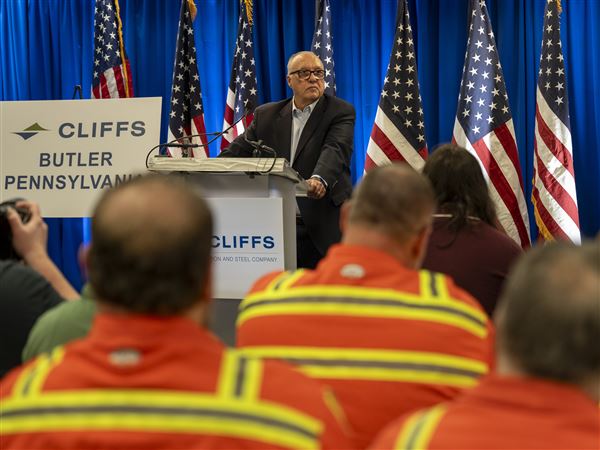About six years ago, there came a point when Project Hosts, a company providing security for mobile apps, simply ran out of workers.
The operation was small — a couple dozen people based in Conneautville, a town of 800 people near Meadville — and demand was pouring in from its clients, primarily health care companies and government agencies, as they shifted information to cloud storage.
There was a temptation to move to a city with a larger pool of workers or to tap into overseas labor, said CEO Scott Chapman.
Instead, the company reached out to Laurel Technical Institute, a school in Meadville that had launched an information technology degree program. Project Hosts moved to bring on students and recent graduates for 90 days, pay them, teach them some skills, and, hopefully, hire them.
On Thursday, President Donald Trump — the former host of “The Apprentice” reality show — signed an executive order that calls for $200 million in funding for apprenticeships. That’s more than double the amount in his original 2018 budget request in May.
The president touted the apprenticeships as the main way to solve a skills gap in manufacturing, IT and health care, saying that, on average, apprentices earn a starting salary of about $60,000 a year while avoiding student loan debt.
“We’re here to celebrate the dignity of work and the greatness of the American worker,” he said during a signing ceremony at the White House with governors, CEOs and some apprentices.
At the same time, Mr. Trump said he wants a pullback of federal oversight and involvement in those programs and is proposing deep funding cuts to existing programs. His budget proposal seeks a 40 percent cut to the Workforce Innovation and Opportunity Act, a $3.4 billion jobs training program passed by Congress in 2014.
That law, which was the first legislative reform of the workforce system in 15 years, placed an emphasis on reaching low-income people and required local workforce agencies to spend a portion of their budgets on training.
The new executive order from Mr. Trump caps a series of events during what the White House called “Workforce Development Week,” which included a visit on Tuesday to a community college in Wisconsin, a meeting of governors and a roundtable with 15 top business leaders.
Also this week, the U.S. Senate introduced legislation to provide a $5,000 tax credit to employers who hire individuals for at least seven months under a government-registered apprentice program.
Apprenticeships, which boomed during the 2000s and lagged during the Great Recession, are on the rebound.
According to the U.S. Department of Labor, 505,000 people across the country held apprenticeships through 21,000 programs registered with the federal or state agencies in 2016. That’s up from a low of 358,000 apprentices in 2011 and surpasses pre-recession levels.
In Pennsylvania, active apprentices totaled 14,110 in 2016, up from 10,821 in 2014, the Labor Department data show.
For years, the construction industry has been the shining model of apprenticeship, bringing together unions that want to grow and companies that need skilled workers. The federal data list the most common occupations as electricians, plumbers, carpenters and construction laborers.
In Western Pennsylvania, unions and companies partner to spend more than $30 million each year on training at the region’s 16 joint apprenticeship training centers. The Builders Guild of Western Pennsylvania, a nonprofit representing 16 building trade unions and six contractor associations, anticipates needing double the number of apprentices to support a commercial building boom in the region and Shell Chemical Appalachia’s ethane cracker plant in Beaver County.
But other companies are embracing programs to address a shortfall of workers skilled in emerging technologies. The big question is how to model them in a largely nonunion workforce and without the kind of support needed from companies.
“We love apprenticeships,” said Stefani Pashman, executive director of Partner4Work, a state-funded agency that connects employers and job-seekers in the Pittsburgh area. “What’s always been missing is easy funding to make it happen and the ability to compel businesses, more than unions, to do it.”
When government funding for new apprenticeship programs first came out a few years ago, “We couldn’t get companies to say, ‘We’re ready to take this plunge’,” Ms. Pashman said.
Apprenticeships are an investment for companies, and they hinge on guarantees that the apprentice will be offered a job. Without an established program, employers felt apprentices would not be properly vetted, she said.
But with a persistent workforce shortage, Ms. Pashman said, “It seems like now we’re willing to make a go at it.”
Partner4Work is seeing the interest with its TechHire initiative, which aims to get people into web developer and quality assurance positions with a series of coding “boot camps,” she said.
On a broader scale, tech groups are trying to build out apprenticeship programs that employers can trust and afford. America Makes, a national initiative based in Youngstown, Ohio, that advances additive manufacturing technology, is scaling up its Apprenticeship Works program that crafts curriculum across 15 different occupations like engineering, mechatronics and robotics. Depending on the occupation, the apprenticeship period ranges from one and a half to four years, she said.
In its second year, it has paired 132 apprentices with employers in 9 states, said Lucinda Curry, director of Apprenticeship Works. With a nearly $5 million grant from the Labor Department, companies spend on average $1,000 for each apprentice, compared with $10,000 without Apprenticeship Works, she said.
“The heavy lifting for building an apprenticeship program is at the front end for a company,” Ms. Curry said.
With an established program, she said, small and medium-sized businesses can buy into it easily.
Project Hosts’ apprenticeship, called the OnRamp Training Program, is open to any student attending a two or four-year college in Western Pennsylvania. It takes people through a 90-day training period, paying them minimum wage, and administering tests on Microsoft Azure, a cloud computing platform used frequently by the company, Mr. Chapman said.
“It’s worth the investment for us to take people who really wanted to be in that area and learn the skill set,” he said. “It’s worked out very well for us.”
Since 2012, the company has hired four to five people each year through the program.
Even if a person ends up working elsewhere, they still have the certificate from Microsoft to show for it, Mr. Chapman said.
Daniel Moore: dmoore@post-gazette.com, 412-263-2743 and Twitter @PGdanielmoore.
First Published: June 15, 2017, 6:35 p.m.





















